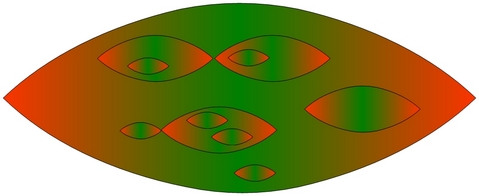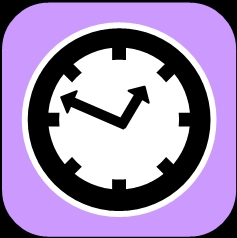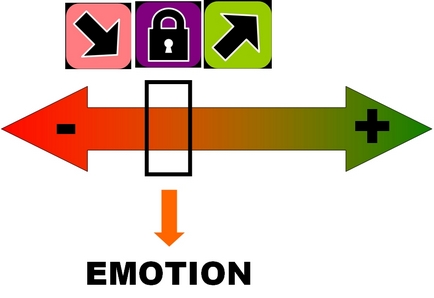Toward a Scientific Approach to Understanding the Appeal of Videogames
(v 1.0.2)
Stéphane Bura
![]()
This is a very exciting time to be a videogame designer.
Videogame design is evolving from a barely understood activity done by genius designers driven by their gut feelings to a craft with shared techniques and methodologies. A common vocabulary cobbled from various fields (interface design, psychology, complex systems, physics, etc.) is slowly emerging. Successes and failures are analyzed...
But it's still a big mess, a large toolbox where any designer can find the right tool to confirm exactly what he believes in. There are no universally accepted truths, only opinions about what makes a great game, whether or not videogames are an art form or whether there is an effective method to teach videogame design.
We lack ways to compare games in an objective manner, ways to describe them in a shared language. Without proper description, there can be no true understanding. Success in videogames still hinges on applying traditional techniques, copying, marketing, luck or genius. And even if success is achieved, there's no guarantee that we can know why it happened.
Arts and sciences have rules and laws, not just techniques. But what are the rules of videogame design?
Where is our redox law? Our perspective rule? Our theory of relativity?
Where are the formal tools we can use to better understand, analyze, and improve games?
How big is the game design space and can we identify its virgin territories?
What are the rules we can bend or break to create totally new experiences?
This article presents a theory of what videogame game design is and explains how to find such rules.
Caveat: If I sound pedant or over-confident in this article, please prefix any affirmation I make with "I modestly believe without being able to prove that". This work has generated many hours of doubt and self-doubt. I do not pretend to teach anyone the definitive meaning of trust, catching-up, fear, or of collecting a power-up. This is an ongoing work, as the version number above attests. If you disagree with me, please tell me why and I'm sure you'll be convincing enough to change my mind.
That said, let's start with easy questions that have clear answers: "What is game design?" and "What is a good game?"
Players don't play to complete games, just as readers don't read to finish books. Players play to feel emotions. Game design is experience crafting for the purpose of emotion engineering.
Game design is intrinsically hard because its output is an interactive system that is twice removed from its goal. The game designer produces rules for interaction that, with the participation of the player, generate game states that themselves induce emotions in the player.
If we can describe a given game state using a set of gameplay variables, we get the following cycle:

Interactions between the player and the game produce changes in the gameplay variables.
For instance, finding a heart container in Zelda and getting a bigger full health bar obviously changes something in the game state. We'll explore below what this could be.
Variations or stability of these variables induce emotions in the player.
For instance, having a bigger full health bar could make him more confident.
Player's emotions influence how he interacts with the game.
For instance, being confident might make him take more risks; pride might keep him chasing a high score; or boredom might make him stop playing altogether.
Note: This article is not about creating emotions with the content, the subject matter or the story, but through interactions with the game alone. Indeed, these are integral parts of the whole - emotions are enhanced by the appropriate setting or story - but the subject has been talked about at length by better qualified people elsewhere. So I'll skip this for now.
Game design works backwards around this cycle, trying to predict player emotions from changes in the interactive system. But our knowledge of the dependencies between interaction and emotion is so sparse that most changes require testing. Testing in part requires implementing the changes, which costs time and money. Thus, in a professional setting where budget is an issue, game design innovation can quickly become a risk.
In The Chemistry Of Game Design, Daniel Cook outlines the benefits game designers would draw from a standardized quasi-scientific descriptive model. Such a model would help game rules design, iterative design, experience design, and even game testing, thus reducing the cost and risk of game design. If we extend his metaphor to biochemistry, we - like Watson and Crick - aim to unlock the secrets of the DNA of game design, but we're still struggling to become Mendels. Gregor Mendel was a 19th century monk who is known today as the father of modern genetics. Around 1860, he spent seven years experimenting with pea strains hybridization in his monastery's garden. His observations combined with some amazing insights led him to the discovery of the characters of heredity.
I think that if there are no widely accepted grand theories of game design, it's because Watson and Crick's discovery was built on Mendel's, and we're still lacking such a base. Mendel's success stems from the tedious repetition of a loop familiar to game developers: tweak some parameters, wait, observe and measure. But Mendel had an advantage over us: being a botanist, he had a fairly good idea of what to observe and measure: colors, shapes, textures, size, growth rates, etc. [Furthermore, he didn't care if his peas looked or tasted great, when game designers are trying to understand what make games good while making good games.]
If Science = Measures + Insight, what should we measure in our games to move toward a scientific understanding of game design, and how can we equate these measures with quality?
Measurement of game assets and gameplay is nothing new (be it Ben Cousins' systematic studies within a genre or Microsoft's usability labs), but I'm looking for abstract game variables that could measure any game in any genre.
If we could agree on what a good game is, the description would be a starting point for finding the gameplay variables that, like botanic for Mendel, would help us objectively measure game characteristics. Unfortunately, there are as many definitions of what a game is that you care to look for. There are fewer of what a good game is but it's still staggering. So I'll just pick one I like:
"A [good] game is a series of interesting choices" - Sid Meier
In my experience, this koan sticks to the memory of every designer who hears it, so there may be some truth in there. Let's parse it.
Choices imply that the player has a certain degree of freedom.
Noah Falstein (referenced here) professes that one can map the availability of choices during a given challenge to a convexity. A typical challenge starts with few choices since the starting conditions are set. As consequences from the first choices materialize, the sub-space of the attainable game space grows, thus increasing the number of available choices. When success or failure conditions are met, the number of choices decreases until the challenge is completed and no choices are left. This is for instance how the game can lead the player toward a climactic ending. What is interesting in this description is that it shows that choices are something we can count.

Convexity of available choices during a challenge
Falstein goes on to note the fractal nature of convexities in a game. Long-term goals can be attained by choosing between options of medium-term missions, themselves composed of short-term challenges.

Sequences of fractal convexities in a game
This means that freedom is not one of the variables we're looking for, but more probably a defining characteristic for a series of variables.
Since more freedom or more choices is not always better, we shouldn't be looking for ways of maximizing the values of our game variables, but for ways of attaining the ranges in which they procure the experience we want to design.
Next, a choice is only real if it is informed, meaningful and irreversible.
Incidentally, this means that some game variable changes can be temporary - those that are the consequences of actions that are not considered choices, like most actions performed by the game's systems.Informed choice: To be able to make a choice, the player must be provided with a system of rules which logic he can understand and that he can trust to be consistent. Otherwise, his choice is random since he cannot predict its consequences.
This is how, for instance, he can choose which unit or building to produce in a RTS.Meaningful choice: The player must have sufficient data to describe the context of his choice, the objects of his desire, his options, and the costs associated which each of them. If there are no costs, it's not really a choice since each option can be tried in turn. If there are neither costs nor contexts, choices don't matter. Context can be simple (Placing a block in Tetris) to extremely complex (Final Fantasy X's sphere grid experience system). Cost can vary from small (Buying a potion when the player has plenty of gold) to big (Choosing one's character class in a MMOG, limiting the content one can experience).
Irreversible choice: A choice, to be truly significant, must create a set of conditions that have a high degree of persistence. Otherwise, this means that the cost paid is meaningless.
For instance, a player can change his mind after committing to a Zerg rush strategy in Starcraft, but it will cost him time, require some effort, and impede his chances of winning.
Finally, making a choice implies that one has the means to act upon it. It would be of no use to the player to decide where to go if Mario couldn't run or jump. So action is also one of our variable characteristics.
A series of interesting choices implies a structured experience, an overarching context. Such experience can be qualified by how it changes the player (self) or his relation to others (social). If the experience didn't affect the player, it would just be wasted time and energy.
Lastly, if the choices are interesting, they're neither boring nor trivial. They're challenging. In A Theory of Fun, Raph Koster posits that fun stems from dealing with challenging situations and acquiring skills to solve them. Similarly, Daniel Cook tracks the player's mastery with skill trees.
This list of concepts needed some structure to become useful. It eluded me until I remembered Will Wright's amazing Dynamics for Designers lecture at GDC 2003. His ability to describe the possible dynamic systems in a neat multi-dimensional taxonomy was eye-opening. I decided to organize these concepts into orthogonal families that would provide the axes for various tables. The first one describes the categories of variables:
 Freedom |
 Mastery |
 Data |
|
 Action |
Opportunities, Tools and Abilities | Trained reflexes, Tactics | Game world resources and collectibles, Operational rules |
 System |
Exploration, Experimentation, Purpose | Learning skills and using them to gain more control |
Preparation, Constitutive rules |
 Self |
Strategy, Creativity | Exploiting skills, knowledge and metagame data |
Mementos, Achievements, Memories |
 Social |
Community support, Shared experience | Competition, Cooperation, Teaching skills |
Status, Metagame, Implicit rules |
Action is the level of the body, the visceral, immediacy and short feedback loops.
System is the level of the mind, the cognitive, logic and plans.
Self is the level of the soul, reflexive thoughts, goals, private experiences and inner changes.
Social is the level of the community, shared experiences, rituals, culture and relationships.
Freedom deals with measuring choices and opportunities for choices.
Mastery deals with measuring skills, their acquisitions and their uses.
Data deals with measuring content, information, rules and real-life objects.
Freedom at the Action level: Everything that empowers or hinders the player while making short-term choices. Action opportunities (An enemy presenting its weak spot, Finding a key in a Zelda dungeon). New tools allowing new interactions (Zelda's boomerang or grappling hook, Mario's flying cap). New abilities (Increased health, Increased strength).
Freedom at the System level: Everything that empowers or hinders the player while making medium to long-term choices. Avenues of exploration (Free-roaming gameplay), clear goals (Getting a quest), letting the player experiment with the rules and creating safe environments where to do so.
Freedom at the Self level: Everything that empowers or hinders the player while making choices about the nature of his experience. Strategic and creative thinking (Specialization, Self-imposed limitations, Speed runs). Content creating tools (Level building, Customization, Machinima).
Freedom at the Social level: Everything that empowers or hinders the player in his relationship with other people. Facilitated multiplayer experience and modes. Sharing content and experiences. Active community. Community support and community management tools. Social image conveyed by the playing experience (Coolness, Geekiness, Weirdness, Novelty, etc.).
Mastery at the Action level: Everything that empowers or hinders skill acquisition and skill use at the immediate or physical level. Athletic skills. Rapid appreciation of the parameters of a situation and appropriate response (which can imply the forming of a medium-term plan). Training. Immediate feedback. Affordance.
Mastery at the System level: Everything that empowers or hinders cognitive skill acquisition and skill use. Giving the player the level of control he needs to act on his plans (agency). Providing information about the constitutive rules (see below) (Tech tree in Civilization, Graphs in SimCity).
Mastery at the Self level: Everything that empowers or hinders skill acquisition and skill use that allow for better control over the game experience. Exploiting metagame data (Reading a walkthrough). Ascribing own meaning to the experience. Feedback about the learning process (Being encouraged, congratulated, rewarded, mocked, stirred up, etc.).
Mastery at the Social level: Everything that empowers or hinders skill acquisition and skill use at the social level. Exploiting the metagame. Learning to bluff. Shaping one's image in the community. Being invested with and performing a role. Competing for ranking. Group play (Guild raids). Being a mentor.
Data at the Action level: Information that takes form in the game, that can be interacted with (Health pack, FFVII's materias). Persistent information at this level can take the form of a collection (Pokémon's Pokédex). Katie Salen and Eric Zimmerman in Rules of Play define the operational rules as what we usually call the "rules of the game", the ones you have to know to be able to play (The ranking of hands in poker, Press A to jump, No credit in RTSs or RPGs). It's the mechanics in Robin Hunicke, Marc LeBlanc and Robert Zubek's MDA framework.
Data at the System level: Information about the game state. Player preparation (Setting-up the Tetris board so as to clear four lines with an I piece, Equipping a dragon-slaying sword before fighting a dragon). The constitutive rules that, according to Salem & Zimmerman, describe the inner workings of the game (AI, Physics, Catch-up behaviors). The player doesn't know them at first but he can learn or guess some of them. It's the dynamics in the MDA framework.
Data at the Self level: Information relative to the relationship between the player and the game, to the act of playing. Trophies, traces left by the experience or created by the player.
Data at the Social level: Information governing the relationships between the player and other people (not necessarily players themselves), as it pertains to the game. Metagame information (Strategy guides, Forum discussions about the game, Fan fiction). Badges and honors linked to reputation and achievements. Salen & Zimmerman's implicit rules, the rules of etiquette, of the magic circle, that should be respected without having to mention them. They include social rules (Don't be a jerk) and game-specific taboos (Don't spy on someone else's monitor in a competitive multiplayer game).
Second caveat: These are not our variables but the categories they belong to. A given game can thus have an influence on several variables in the same category, linked to different processes or systems. For instance, Freedom at the Action level in GTA handles both the choice of paths and of vehicles. This means that this model is still incomplete, each cell being its own dimension. However, I believe this is the most detailed generic model using these variables. A more detailed model would require specific sub-categories for each cell, a work that is well beyond the scope of this article.
Although this table went through many revisions, I cannot affirm that it spans the whole of game design space. After all, I have only experienced a limited subset of the currently known games. However, I seem to be able to describe the effect of any game interaction I can think of as variations in one or several variables belonging to these categories. Whether I'm on to something or have thoroughly blinded myself is for you to judge.
Since these variable categories are abstract, it may be difficult to understand how they're linked to concrete interactions. The two following tables give examples of how game interactions cause changes in variables in each of these categories. The first table shows changes emanating from the game's actions, the second from the player's actions. Changes can be either temporary (requiring little effort to cancel) or persistent (affecting the value of the variable durably).
| GAME INDUCED VARIABLE CHANGE |  Major Decrease |
 Minor Decrease |
 Minor Increase |
 Major Increase |
|||||
 Temporary |
 Persistent |
 Temporary |
 Persistent |
 Temporary |
 Persistent |
 Temporary |
 Persistent |
||
 Action |
 Freedom |
End of big action
opportunity |
Linear path, Difficult to find options (Confusing menus, Quasi-modal controls) |
End of action opportunity, Misleading cue, Temporary loss of ability | Avatar death and respawning, Local reset, Simulation conventions (Usable vs. non-interactive objects) | Action opportunity (Timed door opening), Resource gain (if player can choose how to spend it) |
New minor persistent
ability (Gauge increase)
|
Big action opportunity (Flying cap in Mario), Large resource gain (if player can choose how to spend it) | New major persistent ability (Orthogonal ability - Harvey Smith) |
 Mastery |
End of big advantage opportunity, Misdirecting affordance | Permanent loss of ability, Inappropriate controls, New controller (Guitar Hero, Steel Battalion) | Temporary loss of ability, Randomness | Difficulty increase | Advantage opportunity (Block + Counter combo), New short-term goal (if game is balanced)
|
Affordance, New ability
to trade resource for preparation (Increased life gauge, Buff)
|
Big advantage opportunity (Exploiting an enemy's weak points), New medium-term goal (if game is balanced)
|
Kinesthetic isomorphism (Wii Golf), New persistent ability, Insufficient difficulty increase | |
 Data |
Large resource loss | Inability to complete collection (One way journey in Beyond Good & Evil), Iconic / Symbolic content (Super Mario World) | Resource loss | Allow permanent world change (Broken things, NPC death) | Resource available | Allow permanent world change, Collectible available, XP available | Large resource available | Rare collectible available | |
 System |
 Freedom |
Non interactive scene, Railroading | Deadlock, Hidden depth (Negative feedback for early experimentation) | Guidance (Goal highlighted on map) | Clear goal, Simulation conventions (Most NPCs have no memory) | Concurrent goals, Parallel challenges
|
Unlocking content, Easter egg (Hidden content) | Alternative methods, Parallel challenges with mutual assistance (Noah Falstein) | Safeguards, Error catching |
 Mastery |
Increasing difficulty of current challenge | Inappropriate complexity, Cheating opponent or AI, Hidden rules | Involuntary gameplay mode switch (Stealth / Flight) | Complexity increase, Negative feedback (Catch-up), Inconsistent or random behaviors, Balance, Homeostasis | Hint, New long-term goal (if player has agency)
|
Positive feedback (Limit moves), Negative feedback (Catch-up) | Lowering difficulty of current challenge (Dynamic Difficulty Adjustment - Daniel Arey, Evan Wells) | Consistent behaviors from game entities, Insufficient complexity increase, Iconic / Symbolic content with clear affordance (Super Mario World) | |
 Data |
High cost of failure | Lack of structure, Large score penalty, Unusable resource (Gold excess in Zelda TP) | Preparation erosion (Time-limited buffs, Evolving conditions) | Score penalty, Hidden useful information | Preparation (Buff, Choosing the right equipment for a given challenge, Tactical positioning), Easter egg (Rules data) | Tutorial, In-game help, Score increase (Conditional bonus) | Emergent behavior | Consistent behaviors from game entities, Large score increase (Conditional multiplier) | |
 Self |
 Freedom |
Tedious tasks, Inability to pause or save game | Repetitiveness, Lack of depth, Expensive game (Add-on, Fee), Time-consuming game | Bad context description (No access to mission briefing, No map, Invisible trigger) | No surprises | Checkpoint | Giving player time to think, Low pressure, Numerous checkpoints | Automated quicksave, Shortcut, Sequence of discrete challenges (Planets in Super Mario Galaxy) | Short levels, Quicksave and Instant reload mechanisms, Short game |
 Mastery |
Unwinable challenge (Without the player's clear understanding that he must lose) (Must be detected to trigger story event in stealth game) | Confusing rules with no feedback for wrong interpretation, Inappropriate difficulty, Inefficient interface, Unpredictable behavior, Deception (Unfair Platformer) | Pretend danger (Non-attacking enemies) | Violating cultural rules or meanings | Game opponent with obvious AI flaw | Acknowledgement of player's progress, Encouragement | Teaching a design meta-rule (Enemies can't hurt you until you engage them in combat) | Clear context (Display current mission briefing after loading game), Status, High score, Emergent behaviors |
|
 Data |
Lack of progress feedback, Lack of context in loaded game | Lack of content, Lack of variety, data loss, Short game, Recycled content (Fight same boss twice), Violating IP rules | Minor bug, Mode hiding data from another mode | Breaking the fourth wall, Crash, Losing data | Progress feedback (Map update), Data management in menus, Options configuration, Easter egg (Metagame data) | Customization (outside abilities), Merchandising, Achievements, Metagame data (Play stats) | Introduction to new setting, Story exposition | Save game, Journal, Respect for IP | |
 Social |
 Freedom |
Badly designed matchmaking, Being kicked, Server down | Alliance, Cooperation, Being banned, Unreliable service, Online game closes down | GM arbitration, Toading | Enforced community etiquette | Facilitating player communication between challenges | Modding support | Good matchmaking | User-created content repository or sharing facilitation |
 Mastery |
Irresponsive GMs, Not restricting access to newbie-unfriendly areas | Cheating allowed, Exploits, Lack of community management, Lack of community self-management tools | Allow ganging up | Difficulty to communicate with other players, Lack of real-time communication tools or customization | Player ranking for one challenge (Podium) | Newbie support (Asheron's Call's allegiance system), Training grounds for groups | Cooperative modes, Group achievements, Newbie greeting ritual | Ranks, Badges, Ladders, Automatic publication of high score, Elder game, Complementary roles (Classes in MMOG) | |
 Data |
Lack of official response to problems or rumors | Community data loss, Other players' anonymity | Allow spam | Lack of community nexus | Acknowledgement of players' interactions (TF2, Burnout Revenge) | Player association customization (Insignia), Metagame data (FAQ), Group achievements | Beta testing, Meme, Viral marketing | Reputation system, Player association support, Social network tools | |
| PLAYER INDUCED VARIABLE CHANGE |  Major Decrease |
 Minor Decrease |
 Minor Increase |
 Major Increase |
|||||
 Temporary |
 Persistent |
 Temporary |
 Persistent |
 Temporary |
 Persistent |
 Temporary |
 Persistent |
||
 Action |
 Freedom |
Loss of big action opportunity | Trading resources in large amounts | Loss of action opportunity | Trading resources(Buying abilities with XP, items with gold) | Experimenting with controls | Acquiring minor action skill (Long jump in Mario)
|
Big action opportunity (Flying cap in Mario) | Acquiring major action skill (Rocket jump) |
 Mastery |
Loss of big advantage opportunity, Failure to complete a challenge | Inability to complete a challenge, Grinding | Taking a risk,Tactics | Difficulty increase (Choosing the difficulty level) | Exploiting advantage opportunity (Ongoing combo)
|
Trained reflexes | Exploiting big advantage opportunity (Exploiting an enemy's weak points) | Highly trained reflexes, Known interface metaphor (Drag and drop) | |
 Data |
Large resource waste | Inability to complete collection | Resource waste, Reward perceived as too small | Permanent world change (Broken things, NPC death) | Resource collected | Permanent world change, Collectible found, XP won | Large resource gain | Rare collectible found, Collection completed | |
 System |
 Freedom |
Local resolution | Game over | Sticking to tactics (Setting up an ambush) | Purpose, Clear chosen goal | Generating opportunities, Pursuing concurrent goals | Unlocking content | Trying alternative methods | Aimless wandering |
 Mastery |
Failure of wrong plan | Inadequate mental model | Losing the lead | Opponent's negative feedback (Opponent catch-up), Inefficient rote learning | Exploiting preparation, Taking the lead, Voluntary gameplay mode switch (Stealth / Kill) | Completing a challenge, Chunking, Statistical analysis | Lowering difficulty of current challenge (Choosing the difficulty level) | Grokking the rules, Exploiting emergent behavior, Winning, Min-maxing | |
 Data |
Costly failure of right plan | Pursuing costly wrong plan | Loss of preparation, Mistake | Forgetting a rule | Preparation (Buff), Opponent's mistake | Ability customization, Learning a rule, Score increase | Loss of understanding | Learning meta-rules, Perceptual breakthrough, Large score increase | |
 Self |
 Freedom |
Misunderstanding feedback, Doing tedious tasks | Quit, Grinding, No experimentation | Being stumped by a puzzle, Being unaware of a choice, Being lost in a world | Favorite tools or methods | Speculating, Experimenting | Setting one's own challenges, Playing a role | Planning, Strategy, Taking a shortcut (Teleporting) | Making new content, tools or rules, Apophenia |
 Mastery |
Pareidolia, Misunderstanding the rules, Big recurring mistake | Perceived cheating on the part of the game, Apophenia, Misunderstanding the rules | Recurring mistake | Blind spot | Reactivity, Correct prediction of opponent's choice | Training, Exploring rules and content | Correct prediction of opponent's strategy | Mastering a skill, Learning a pattern (Raph Koster), Obtaining high score, Looking for emergent behaviors | |
 Data |
Losing access to data | Losing data, Violating IP rules | Temporary forgetting data | Forgetting data | Options configuration, Own progress record (Drawings in Zelda PH) | Customization (outside abilities), Using metagame data (Reading a FAQ), Things, Achievements | First encounter with content type or rule system | Save game, Journal, Appreciation of IP use | |
 Social |
 Freedom |
Cooperation | Alliance, Team play | Short-term cooperation (Medic in TF2) | Community etiquette, Pledge | Discussing about experience | Group setting one's own challenges, creating own interpretation or mythology, Roleplaying to an audience | Multiplayer Planning | Betrayal, Sharing new content, tools or rules, Anticonformism (Non-violent Warrior character) |
 Mastery |
Being subjected to griefing | Anticonformism (if shunned) (Roleplayer on PvP server), Community feuds | Humiliation, Violating cultural rules or meanings, Low signal to noise ratio | Bad reputation, Failing to attend group activity | Bluff, Deception, Recurring opponent's mistake, Being group tactician | Dominating an opponent, Mentoring, Teaching a skill, Good reputation, Correct response to cultural cue | Psychological warfare, Cooperation, Multiplayer training | Status, Publishing high score, Sharing secret exploits, Team victory, Being a leader | |
 Data |
Losing access to community (Server / matchmaking down),Trolling | Player association dissolution, Losing community data | Blocking chat channels / users | Player association reorganization, Unmanageable community size / dynamics | Managing social network, Online trading and game objects auctions | Creating metagame data (Writing a FAQ, Community record keeping), Achievements, Team achievements | Community event, Rumor, Meme, Past experiences of playing the same game with the same people | Community lore, Community rituals, Roles, Reputation, Relationships, Whuffie, Player association | |
Some items appear in several cells. Complex interactions, like for instance "Being stealthy", have too many concurrent effects on the game variables to fit into two or three cells. They must be broken down into simpler parts if we want to analyze their influence.
If I have chosen to represent these game variables as mono-dimensional numeric variables, speaking of increase and decrease in their values, I have no idea which units I should use for them. Is freedom quantified by counting available choices weighted by their importance or is it a succession of fitness functions rewarding more and more states in the game space? At this early stage, it matters little if we can recognize fluctuations in values and roughly evaluate their relative sizes, which I believe is the case.
Spurred by Nicole Lazzaro's work on players' emotions, I tried to link game variables and emotions. I came to believe that a given emotion could be associated with the values and variations of one or several variables. If this were the case, this would be a template for a game design rule, a rule explaining how a given emotion can be achieved:

A game design rule template
The two-headed arrow describes the possible values for the variable. The rectangle indicates the range in which a decrease, a persistent value or an increase generates conditions for the associated emotion.
And here are two instantiations of this template:
If you reduce the number of choices a player has at the cognitive level - which means that he may have the tools and plans to face a challenge but is overmatched or doesn't have the opportunity to use them - and maintain him in this state (Low Freedom at the System level), you may drive him to despair. But if you then give him an opportunity (Increase), suddenly there's a way out. Suddenly, there's hope.

A game design rule
If you maintain a balanced difficulty that provides challenging obstacles with appropriate rewards and acknowledgements of the player's successes (High Mastery at the Self level), you can induce a sense of pride in him. Now, offer him an easy way out of a challenge and reward him disproportion ally for taking it (Decrease), and you induce the shame that comes with ill-gotten gains.

Another game design rule
Of course, such conditions don't guarantee that the player will feel the chosen emotion. They just create a context that is favorable to the expression of this emotion. Knowing that, the game can provide the player with corresponding feedback or cultural cues, like booming music to underline hope, without causing an emotional dissonance.
Here's a table listing some emotions associated with the values and variations of the gameplay variables. As previously, some items may appear in several cells. You'll notice that I use the widest possible definition of "emotions" in order to also cover other mental states, perceptions and feelings.
| EMOTIONS | TOO LOW | LOW | HIGH | TOO HIGH | |||||
|
 Persistent |
 Increase |
 Decrease |
 Persistent |
 Increase |
||||
 Action |
 Freedom |
Disgust, Inescapableness | Fear, Shock, Buyer's remorse | Claustrophobia, Dread | Suspense, Anticipation of change | Distraction, Slapstick humor (with player's avatar), Buyer's remorse | Awareness, Exhilaration, Appreciation of possibilities, Addiction to growth | Disorientation | Fear of choice, Paralysis |
 Mastery |
Discouragement, Hopelessness, Humiliation, Powerlessness | Fear, Desire of revenge, Perseverance | Inadequacy, Loss of concentration, Caution, Nervousness | Gambling impulse, Hope | Doubt, Rush, Gambling impulse, Feeling challenged, Fear of failure | Confidence, Willingness to take risks, Feeling in control of one's actions, Grace | Fiero, Excitation, Satisfaction, Showing off | Boredom, Pointlessness, Impatience | |
 Data |
Discouragement, Unfairness, Infantilization | Loss, Annoyance, Grief, Regret | Trust in the system to remain simple / understandable, Feeling ignored | Reinforcement through positive feedback | Reinforcement through negative feedback | Agency, Expectation (Grinding toward level-up) | Compulsive desire to complete collection, Slapstick humor | Underwhelming success, Infantilization | |
 System |
 Freedom |
Loss of trust, Arbitrariness, Feeling manipulated, Despair | Feeling constrained, Perseverance | Fatigue, Feeling fated, Self-doubt | Surprise, Hope | Purpose, Comfortable routine | Zen, Trust in the system to provide solutions | Forward thrust ("Living off the land"), Adapting to conditions without planning, Rush | Fear of choice, Paralysis, Loss of agency |
 Mastery |
Loss of trust, Disgruntlement, Overwhelmed by complexity, Rage, Stress | Frustration, Self-deprecating humor, Bravery | Feeling of randomness, Feeling stupid | Pleasure of learning, Hope | Unpredictability, Surprise | Agency, Trust in rules logic, Coherence, Projection, Trust in the system to be fair, Willingness to experiment, Zoning out, Gambling impulse, Caillois' ludus | Feeling smart, Breakthrough, Insight, Meta-humor | Lack of challenge, Predictability, Boredom | |
 Data |
Meaninglessness, Apathy | Self-aggravation | Detachment, Scapegoating | Curiosity | Mystery | Belief in the game world, Empathy, Interest for complexity | Feeling unique, Situation comedy | Confusion, Overwhelmed by complexity | |
 Self |
 Freedom |
Apathy, Impatience, Disinterest, Anguish over overwhelming duty (Micromanagement) | Stubbornness, Caillois' ilinx (Vertigo) | Concentration, Importance, Duty, Involvement, Enjoying the ride, Being carefree, Caillois' mimicry* (Paracosm) | Doing the impossible, Curiosity | Purpose, Focus | Comfort, Certainty, Escapism, Creativity, Caillois' paida (Sandbox play, Garry's mod) | Feeling lost, Reflection, Transformation, Caillois' ilinx (Realizing the breadth of the experience) | Purposelessness, Insignificance |
 Mastery |
Surrender, Anger | Frustration, Self-deprecating humor | Anticipation of failure, Caillois' alea (if no applicable probabilities) | Vindication, Discovery, Pleasure of finding things out | Shame (ill gotten gain), Laziness (Choosing an easy path) | Anticipation of accomplishment, Self-esteem, Willingness to learn, Caillois' agon** | Authorship, Pride | Inflated ego | |
 Data |
Sense of wasting energy and time | Disorientation from lack of context | Feeling stuck, Unease, Sadness | Anticipation of local resolution, Compassion | Identification, Aesthetic appreciation, Aesthetic rejection | Familiarity, Interest for variety, Immersion, Contentment, Caillois' mimicry* (Simulation) | Wonder, Awe, Joy | Obsession, Wastefulness | |
 Social |
 Freedom |
Aloofness, Shyness, Anguish over community duty (Too many friends or social obligations) | Justice, Peer pressure | Duty, Honor, Involvement, Caillois' mimicry* (Roleplaying) | Guilt, Breaking taboos | Feeling Honorable (Commitment, Doing the right thing), Egoboo | Belonging to a clique, Caillois' paida (Nomic, Calvinball) | Injustice, Being accepted, Caillois' ilinx (Realizing the breadth of the game as a medium) | Insignificance, Detachment |
 Mastery |
Hate | [Observed] Schadenfreude | Anticipation of group failure | Group vindication | Shared shame (ill gotten gain), Needing to blame someone | Anticipation of group accomplishment, Dignity, Respect, Superiority, Caillois' agon** | Pride, [Observed] Naches, [Observed] Admiration, Taunting | Contempt, Scorn for opponent | |
 Data |
Fanatism through secrecy | Disorientation from lack of connectivity | Anonymity, Isolation, Appreciation of rarity / secrecy / uniqueness | Feeling of human connection (ESP Game), Compassion | Affinity, Meta-humor, Appropriation | Belonging, Intimacy, Immersion, Love, Caillois' mimicry* (Shared fantasy) | Bragging rights, Completeness (Great choreography in competitive / cooperative gameplay) | Feuds, Arrogance, Sectarianism, Fanatism | |
* Mimicry requires focus, implicit rules and a somewhat applicable knowledge of the mimicked process.
** Agon can practically occur anywhere, even in Too Low Mastery if there is randomness (Parcheesi) or metagame factors (Rock Paper Scissors).
Using the previous tables, a designer can move backwards in the (interactions / game variables / emotions) loop and design game systems that can induce chosen emotions. This requires two steps. First, the designer picks the emotions he's looking for in the emotions table and finds out which game variables are involved, as well as the required ranges of values and their variations. Second, he chooses in the game and player tables which appropriate game systems can generate these values and variations, either from the game's actions or by giving the player opportunities to make these changes.
Let's look at three examples: inducing nurturing instinct, flow, or the sensation of being hunted.
Nurturing instinct = Empathy + Agency + Comfortable routine + Surprise + Naches
Empathy (Persistent High Data at the System level): Consistent behaviors from game entities (Player can understand the creatures and anticipate their behaviors), Emergent behavior (Creatures are complex enough to seem intelligent and aware of the interactions), Preparation (Player's actions take some effort which increases their perceived value), Ability customization (Creatures respond differently to customized tools, as is they have tastes and preferences), Learning a rule (Creatures are complex enough that the player must spend time to learn their behaviors), Score increase (Creatures give positive feedback when pleased).
Agency (Persistent High Data at the Action level, Persistent High Mastery at the System level): Permanent world change (Player's actions change the creatures, Mistakes can hurt them), Collectibles (Customized tools, Rare behaviors, Rare creatures), XP (System level track of progress and effort needed), Resources (Put the emphasis on the cost of interaction and the player's commitment) (Treats, Meds), Voluntary gameplay mode switch (Player can choose the creatures' activities), Lowering difficulty of current challenge (Slow rhythm, No pressure, No insurmountable challenges), Iconic / Symbolic content with clear affordance (Tools' and activities' functions are clear, one per tool or activity), Positive & negative feedbacks (Creatures show the player whether an interaction is pleasing or not), New long-term goal (Creatures express needs that take a lot of effort to satisfy).
Comfortable routine (Decrease when High Freedom at the System level): Guidance / Clear goal (Creatures' needs generate challenges, Challenge solution is often obvious; it requires investment, not skill), Simulation conventions (Whether inactivity is perceived by the creatures, Whether challenges can be concurrent, etc.), Clear chosen goal (Player can work toward a specific change in the creature) (Creature evolution, Creature training), Local resolutions (Medium-term challenges with little impact on global change, Mistakes can be corrected).
Surprise (Increase when Low Freedom at the System Level, Decrease when High Mastery at the System level): Unlocking content / Inconsistent or random behaviors (Breaks the routine's monotony) (Rare events, random or with rare conditions), Easter eggs (Reward experimentation with creatures).
Naches (Pride for one's child's or mentee's accomplishments) (Increase when High Mastery at the Social level): Mentoring (Player can give goals and progress feedback to the creatures), Cooperation (Creature skill acquisition requires a tight feedback loop with the player), Correct response to cultural cue (Creatures display signs of effort when learning, Creatures' skill acquisition is punctuated by joyful behavior on their part), Teaching a skill / Recurring opponent's mistake (Creatures have disabilities that they can overcome through being taught).
Flow = Exhilaration + Confidence + Coherence + Forward thrust - Boredom
Exhilaration (Persistent High Freedom at the Action level): Action opportunities (Limited constraints on move set, Short-term athletic skill challenges), Resource gain (Steady flow to feed preparation or positive feedback - see below).
Confidence (Persistent High Mastery at the Action level): Affordance (No ambiguous stimuli), Highly trained reflexes / Kinesthetic isomorphism (Player can play without thinking about the controls), Advantage opportunities (Player can identify which sequences of moves can solve local challenge).
Coherence (Persistent High Mastery at the System level): Consistent behaviors from game entities (Player can predict next game state and react accordingly), Positive feedback (Reward local successes with easy challenges, power increase or score multipliers), Hints (Warn the player of imminent danger), Opportunities for exploiting preparation (Short-term tactical combos), Voluntary gameplay mode switch (Player can use favorite tactics), Opportunities for taking the lead (Player catch-up), Opportunities for exploiting emergent behavior (Chain reactions, Player can provoke opponent's mistakes).
Forward thrust (Increase when High Freedom at the System level): Alternative methods / Concurrent goals (Player can use favorite tactics), Generating opportunities (Even if caught off-guard, player can maneuver so he can fall back to favorite tactics), Safeguards (Player can recover from near defeat).
Avoid Boredom (No Excess Mastery at the Action or System levels): Difficulty increase, Complexity increase, Involuntary gameplay mode switch, Random behaviors (Sustained level of perceived difficulty at the Action level, Use semi-random temporary increases in difficulty to keep the player on his toes) (Waves of enemies, One unpredictable enemy type, Periods of low availability of tactical resources).
Being Hunted = Dread + Unpredictability + Caution + Anticipation of failure - Hope
Dread (Persistent Low Freedom at the Action level): Linear path (Limited number of significant path choices, Limited number of hiding places), Temporary loss of ability (Being slowed down by a wound), Resource loss (High cost for being caught), Limited opportunities to escape when seen.
Unpredictability (Decrease when High in Mastery at the System level): Negative feedback (Hunters catch-up, No possible escape), Inconsistent or random behaviors (Hunters cannot be tracked or their positions predicted), Involuntary gameplay mode switch (Stealth / Flight).
Caution (Persistent Low Mastery at the Action level): Taking a risk (Risky portions in main path or secondary path, where the player can be spotted more easily), Misdirecting affordance (Traps).
Anticipation of failure (Persistent Low Mastery at the Self level): Pretend danger (Ominous noises), Perceived cheating on the part of the game (How can they always find me?), Opportunities for recurring mistake (Hunters can hear the player when he makes noises).
Avoid Hope (No Increase when Low in Mastery at the Action level, Freedom at the System level and Mastery at the System level): Can't exploit advantage opportunity (Hunters show no weaknesses), Can't pursue concurrent goals (Fleeing prevents access to resources or means of escape), Can't exploit preparation (Hunt can only end by a narrow escape that feels lucky).
One can use the game variables table to sum-up the appeal and flaws of a game as they pertain to its systems and the emotions they induce. In the following examples, the darker a cell is, the lower the emotional appeal created by its associated variables. I tried to use common sense when judging this appeal, since some emotions might be desirable in a given context (Fear in a survival horror game) and not in another (Fear in puzzle game).
Note: That a game has a grayed-out cell doesn't mean that this makes it bad, it is just a consequence of the design choices. For instance, Portal is a short game because it's been purposefully designed as one: its length is part of the overall experience it offers. Some players might still find it too short.
| PUZZLE QUEST |  Freedom |
 Mastery |
 Data |
 Action |
Moment to moment tactics (Go for damage, mana or permanent resources) | Combos, Proved match-3 gameplay | Choice of tools (Class, Equipment, Spells), Collectibles (Quests, Unique items) |
 System |
Limited replayability | Varied uses of core gameplay, Advanced tactics (Spell combos, Spells that don't end the turn) | Continuous growth: Player can't lose resources, every moment spent playing is rewarded (XP & Gold won even if battle lost), Leveling compulsion (Rank spells and purchasable items) |
 Self |
Short gameplay bits, Repetitive encounters | Underwhelming ending | Limited sense of accomplishment (No achievements like "Longest combo" or "Most Damage"), Classic story |
 Social |
Multiplayer mode | Easy to demonstrate and teach | No unique experiences to share |
| SUPER MARIO GALAXY |  Freedom |
 Mastery |
 Data |
 Action |
Two "interact with object" commands (Stomp & spin), Limited use of basic commands | Refined user-friendly controls (Wall hang), Easy to win (60 stars), Hard to finish (121 or 242 stars) | Star bits collection (Even if use is limited) |
 System |
Iconic world (No hidden rules) allows clear understanding of possibilities | Iconic world manages to offer surprises, Life gauge adjusted to fit medium-term goal oriented gameplay | Breadth of core gravity gameplay, Very creative and varied levels built around simple constitutive rules (2D levels, Boss levels) |
 Self |
Series of medium-term goals, Hub structure with large choice, Great non-intrusive camera, Lack of purpose | Variety reduces usefulness of acquired skills (Few 2D levels, Blue stars hopping, Flying) | Successful re-imaging of IP elements, Beautiful world, Limited level replayability (Despite comet modes), Mostly irrelevant story, Countdown drives toward completion (May cause frustration) |
 Social |
Player 2 mode | Limited cooperation in 2 players mode, Lack of tricks or secrets to share | No unique experiences to share |
| PORTAL |  Freedom |
 Mastery |
 Data |
 Action |
Experimentation rewarded, Little pressure put on the player | Skill challenges (Shooting while falling) | Uncluttered world, Rich contextual feedback for most actions |
 System |
Depth of core gameplay | Game is a long tutorial, Perceptual breakthrough, Challenging additional gameplay modes | Unique achievements |
 Self |
Short levels, Quicksave and Instant reload, Portable install, Short game (Low required investment), Linear experience (No meaningful choices / Enjoying the ride), Login required to play | Subtle taunting mixed with constant positive feedback acknowledging progress | Unique tone, Humor, Inside jokes (References to HL), Short game (Small amount of content) |
 Social |
User-created levels support | Tantalizing word of mouth ("You must play to understand"), YouTube and spectator-friendly, Slow pace allows cooperative problem solving | Memes ("The cake is a lie", Still Alive, Weighted Companion Cube) |
I'm not trying to prove that Portal is objectively a better game than Puzzle Quest. I'm saying that, personal taste aside, Portal provides a more complete experience.
By the way, I believe that the brilliance of Portal doesn't stem solely from its completeness, but also from its elegance. Elegance is a quality of the relations between the cells of the table. Since it's about meta-design rules, it'll be the subject of another article.
Is this a useful tool? I don't know yet. I hope that like Mendeleev's periodic table of elements, this or a different model will help game designers establish a common language devoid of fuzziness and interpretations. A language that would allow us to better work together, share theories and turn our craft into an art. And like Mendeleev and his table, such a model might even lead us to predict the existence of yet unknown elements, unexplored territories in the game design space.
Gregor Mendel's sheer dedication and patience as well as his scientific rigor are an inspiration to anyone attempting such an endeavor. Mendel worked alone, when game designers are part of a vibrant and well connected community. Somehow, I don't think we'll have to wait seven years to produce a work worthy of his efforts.
*****
If you want to talk about all this around drinks, I'll be at this year's GDC.
*****
Thanks to Yves Grolet, Jurie Horneman, Raph Koster, Mike Sellers, Daniel Cook, Timmy Gilbert, Noah Falstein, Robin Hunicke, Doug Church.
Version History
v 1.0.2 February 17th 2008: Added "Known interface metaphor" and "Apophenia" in player's table. Added "Zoning out", "Egoboo" and "Self-esteem" in emotions. Changed "constituative" to dictionary-friendlier "constitutive". Thanked Jurie Horneman properly. Jurie has been so instrumental in helping me shape and share these ideas that I can't believe I omitted him. Sorry Jurie :) Fixed some typos, mistranslations and added a few links.
v 1.0.1 February 13th 2008: I had totally forgotten about Puzzle Quest's multiplayer mode. Sorry, Infinite Interactive, I love your game! Thanks to Rich Wilson for catching that.
v 1.0.0 February 11th 2008